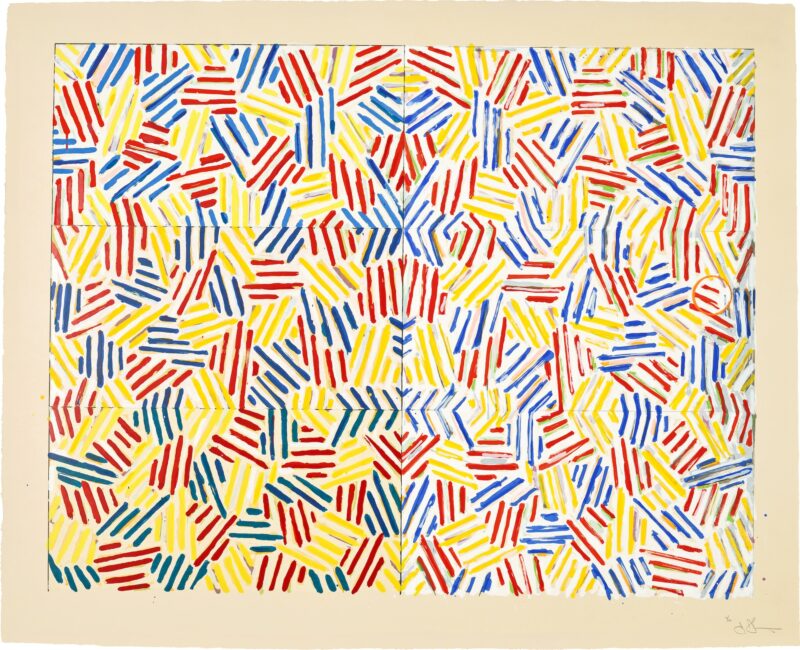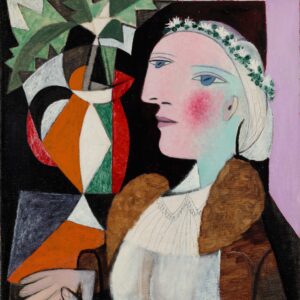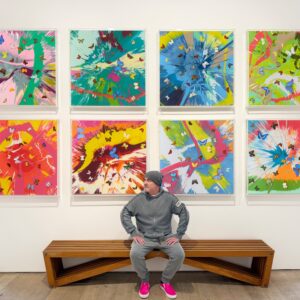Phillips 20th Century & Contemporary Art Evening Sale is this Friday 13th October in London. The auction consists of 43 lots and, to help you navigate the selection on offer, Rosanna Widén, Head of Sale, has selected her top 5 picks.
Lot 2 Stefanie Heinze

Berlin-based artist Stefanie Heinze’s paintings feature hallucinatory, liquid forms that merge with vivid colors to create surreal compositions. Her work showcases playful, invented characters crafted from clever combinations of body parts, animal hybrids, and organic forms, all realized in vibrant technicolor. Median (Fin Fatale) represents Heinze’s auction debut and demonstrates her signature wordplay, playfully referencing the femme fatale trope while deconstructing gendered cultural constructs. The femme fatale archetype, common in film and literature, is typically a mysterious and attractive and highly intelligent with morally ambiguous qualities, often aligned with historical archetypes like the Witch and known for seducing men with her charms.
Lot 11 Hernan Bas

Hernan Bas, a Miami-born artist, infuses his evocative paintings with androgynous dandies, fragmented landscapes, and spiritual elements, reflecting his interests in literature, the occult, and queer culture. Growing up in the Florida Everglades, Bas was deeply influenced by the wild environment, which fueled his belief in paranormal folklore tales like werewolves and UFOs, connecting these ideas with his identity as an openly gay man. His artwork features exquisite androgynous figures set against dreamlike landscapes. His Voice Would Be the Loudest in the Land, created in 2009, exemplifies his earlier landscape work, characterized by vibrant, semi-abstract compositions.
Lot 12 Luc Tuymans

Belgian artist Luc Tuymans’ painting Rome, part of his Les Revenants series, explores the potency of images and their enduring impact. Tuymans investigates the interplay between illusion and reality, visual culture’s forms and functions, and the power of images. The series delves into the history of the Jesuit Order’s influence on Europe’s socio-political landscape and religious power’s persistence. Rome depicts an elevated view of St. Peter’s Basilica in soft pastel hues, emphasizing its monumental architecture and the theatricality of religious ceremonies. The basilica symbolizes both the Catholic Church and Rome itself, highlighting the role of images in conveying abstract ideas and power.
Lot 14 Joseph Albers

Josef Albers, renowned for his Homage to the Square series, pioneered abstract minimalism and colour theory. Using nested squares of varied hues arranged geometrically, he examined colour relationships, experimenting with tones and chromatic intensity to evoke optical and psychological effects. This iconic series blended aspects of colour, amplifying interactions between rhythm and space, and challenging traditional notions of art. An exceptionally rare piece from this series, the present work is one of only 74 where Albers deviated from the square format, emphasizing his exploratory approach to colour and abstraction through luminous yellow, gold, and ochre tones.
Lot 42 Alina Szapocznikow

Autoportret II by Alina Szapocznikow features three crown-like wings that unveil a mysterious smiling face, while its body transitions into lifted toes and an arched foot. This surreal self-portrait aligns Szapocznikow with female Surrealists. Viewed from the front, it appears fragmented and unsettling, but from different angles, the central wing transforms to reveal her face, throat, and upper chest. Szapocznikow’s art reflects mid-century Pop Art’s commentary on commodification of women, Dada’s influence, and sculptural exploration of form and material. Born in Poland to a family of Jewish medical professionals in 1926, Szapocznikow witnessed first-hand some of the most unimaginable horrors committed against the body in the 20th century, she was first ghettoised when Poland was invaded by the Nazis and later transferred to Bergen-Belsen via Auschwitz where she survived her teenage years working in a camp hospital. Separated from her mother in 1944 and assuming that her family had all perished she fled to Czechoslovakia, where she trained as a stonemason and sculptor at the Higher School of Arts and Industry in Prague. Relocating to Paris in 1947, Szapocznikow continued her studies, working in a traditionally classical style, crafting solid, sturdy bodies in stone in defiance of her own direct experience with the vulnerability of human flesh.







